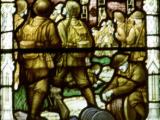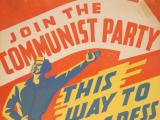After lengthy negotiations, representatives of North Korea and the United Nations signed an armistice on the ceasefire line between North and South Korea.
Korean War
Events In History
The TSS Wahine was chartered by the New Zealand government to transport Kayforce troops to the Korean War. Shortly after leaving Darwin it ran aground on Masela Island in the Arafura Sea, east of Timor.
Kayforce suffered its first fatal battle casualty with the death of Second Lieutenant Dennis Fielden.
Articles
Links - military history

Links to military resources including personnel records, medal winners and war graves. Read the full article
Page 5 - Post Second World War
Links to further information about New Zealand's military participation since the Second World
The Cold War

Although the origins of the so-called Cold War can be traced back to the Bolshevik revolution of 1917, this intense ideological struggle between the Western powers and the Soviet Union really began after the Second World War. Read the full article
Page 2 - Overview
New Zealand’s participation in the Cold War was shaped by its decision to support the Western powers in their confrontation with the Soviet Union after the Second World War.
Page 3 - Choosing sides
New Zealand backed Britain and the United States against the Soviet Union as the Cold War began in the late 1940s. Like the other Western Allies, New Zealand’s relationship with
Korean War
New Zealand was involved militarily in Korea from 1950 to 1957, first as part of the United Nations 'police action' to repel North Korea's invasion of its southern neighbour, and then in a garrison role after the armistice in July 1953. Read the full article
Page 1 - New Zealand in the Korean War
New Zealand was involved militarily in Korea from 1950 to 1957, first as part of the United Nations 'police action' to repel North Korea's invasion of its southern neighbour, and
Page 2 - Background
That two Korean states existed in 1950 was an outcome of arrangements for the surrender of Japan in August 1945 which had resulted in the entry of both Soviet and American forces
Page 3 - The 'first' and 'second' Korean Wars
New Zealand was one of the first states to answer the Security Council's call for combat assistance (16 would eventually do so). The government offered two frigates on 29 June
Page 4 - Kayforce joins the conflict
In January 1951 a further New Zealand contingent joined the UN Command – Kayforce. On 26 July 1950, in response to another plea from the UN Secretary-General, Trygve Lie, the
Page 5 - The Commonwealth Division
In October 1951, now deployed on the Imjin River as part of 28th British Commonwealth Infantry Brigade, the New Zealand gunners took part in Operation Commando, an advance of 5 to
Page 6 - End of the conflict
At the end of 1951, a stalemate emerged as both sides improved their defensive positions. The front took on the character of a hilly Western Front. Much bitter fighting took place
Page 7 - Impact of the war
About 4700 men served in Kayforce and a further 1300 on the frigates during the seven years of New Zealand’s involvement in Korea. Forty-five men lost their lives in this period,
Page 8 - Korean War Roll of Honour
Roll of Honour of New Zealanders killed during the Korean War,
Page 9 - The Bob Jagger photographs
Collection of previously unpublished images of the Korean War by Kiwi gunner Bob
Page 10 - Kiwi stories
Listen to some of the stories of New Zealanders involved in the Korean War,
Page 11 - Further information
Recommended links and books relating to New Zealand and the Korean
New Zealand and the United Nations

New Zealand has a tradition of commitment to the concept of collective security. It was a member of the League of Nations between the world wars and was active in the establishment of the United Nations in June 1945. Read the full article
Page 3 - Participation in the United Nations
The United Nations Charter established six principal organs to achieve its aims. New Zealand has played a part in all of these
Military mascots

New Zealanders have one of the highest pet-ownership rates in the world. Wartime was no different. Take a tour through this menagerie of military mascots: dogs, cats, donkeys, monkeys, pigs, goats and birds. There's the famous bull terrier Major Major, along with the less well-known, but very cute, slow loris adopted by 1 RNZIR in Borneo. Read the full article
Page 4 - Other military mascots
Mascots we would like more information about, mainly from post-Second World War
The Royal New Zealand Navy
Seventy years old in October 2011, the Royal New Zealand Navy is today an integral part of the New Zealand Defence Force. But its 1941 establishment was the result of a long process of naval development. Read the full article
Page 6 - Post-war operations
Like all the services the RNZN faced difficulties of readjustment to peacetime conditions, not only in drastically reducing numbers but also in determining the shape of the









































